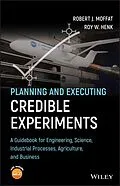Covers experiment planning, execution, analysis, and reporting
This single-source resource guides readers in planning and conducting credible experiments for engineering, science, industrial processes, agriculture, and business. The text takes experimenters all the way through conducting a high-impact experiment, from initial conception, through execution of the experiment, to a defensible final report. It prepares the reader to anticipate the choices faced during each stage.
Filled with real-world examples from engineering science and industry, Planning and Executing Credible Experiments: A Guidebook for Engineering, Science, Industrial Processes, Agriculture, and Business offers chapters that challenge experimenters at each stage of planning and execution and emphasizes uncertainty analysis as a design tool in addition to its role for reporting results. Tested over decades at Stanford University and internationally, the text employs two powerful, free, open-source software tools: GOSSET to optimize experiment design, and R for statistical computing and graphics. A website accompanies the text, providing additional resources and software downloads.
- A comprehensive guide to experiment planning, execution, and analysis
- Leads from initial conception, through the experiment's launch, to final report
- Prepares the reader to anticipate the choices faced throughout an experiment
- Hones the motivating question
- Employs principles and techniques from Design of Experiments (DoE)
- Selects experiment designs to obtain the most information from fewer experimental runs
- Offers chapters that propose questions that an experimenter will need to ask and answer during each stage of planning and execution
- Demonstrates how uncertainty analysis guides and strengthens each stage
- Includes examples from real-life industrial experiments
- Accompanied by a website hosting open-source software
Planning and Executing Credible Experiments is an excellent resource for graduates and senior undergraduates-as well as professionals-across a wide variety of engineering disciplines.
Autorentext
ROBERT J. MOFFAT, PHD, is a Professor Emeritus of Mechanical Engineering at Stanford University. He proved engines for General Motors and is the former President of Moffat Thermosciences, Inc. His main areas of research include convective heat transfer in engineering systems, experimental methods in heat transfer and fluid mechanics, and biomedical thermal issues.
ROY W. HENK, PHD, designed aerospace engine components and has conducted experimental tests in industry, a government lab and internationally. He has been a Professor in the USA, South Korea, and most notably at Kyoto University in Japan. His research includes experiment design, energy conversion, turbomachinery, and thermal fluid physics.
Inhalt
About the Authors xxi
Preface xxiii
Acknowledgments xxvii
About the Companion Website xxix
1 Choosing Credibility 1
1.1 The Responsibility of an Experimentalist 2
1.2 Losses of Credibility 2
1.3 Recovering Credibility 3
1.4 Starting with a Sharp Axe 3
1.5 A Systems View of Experimental Work 4
1.6 In Defense of Being a Generalist 5
Panel 1.1 The Bundt Cake Story 6
References 6
Homework 6
2 The Nature of Experimental Work 7
2.1 Tested Guide of Strategy and Tactics 7
2.2 What Can Be Measured and What Cannot? 8
2.2.1 Examples Not Measurable 8
2.2.2 Shapes 9
2.2.3 Measurable by the Human Sensory System 10
2.2.4 Identifying and Selecting Measurable Factors 11
2.2.5 Intrusive Measurements 11
2.3 Beware Measuring Without Understanding: Warnings from History 12
2.4 How Does Experimental Work Differ from Theory and Analysis? 13
2.4.1 Logical Mode 13
2.4.2 Persistence 13
2.4.3 Resolution 13
2.4.4 Dimensionality 15
2.4.5 Similarity and Dimensional Analysis 15
2.4.6 Listening to Our Theoretician Compatriots 16
Panel 2.1 Positive Consequences of the Reproducibility Crisis 17
Panel 2.2 Selected Invitations to Experimental Research, Insights from Theoreticians 18
Panel 2.3 Prepublishing Your Experiment Plan 21
2.4.7 Surveys and Polls 22
2.5 Uncertainty 23
2.6 Uncertainty Analysis 23
References 24
Homework 25
3 An Overview of Experiment Planning 27
3.1 Steps in an Experimental Plan 27
3.2 Iteration and Refinement 28
3.3 Risk Assessment/Risk Abatement 28
3.4 Questions to Guide Planning of an Experiment 29
Homework 30
4 Identifying the Motivating Question 31
4.1 The Prime Need 31
Panel 4.1 There's a Hole in My Bucket 32
4.2 An Anchor and a Sieve 33
4.3 Identifying the Motivating Question Clarifies Thinking 33
4.3.1 Getting Started 33
4.3.2 Probe and Focus 34
4.4 Three Levels of Questions 35
4.5 Strong Inference 36
4.6 Agree on the Form of an Acceptable Answer 36
4.7 Specify the Allowable Uncertainty 37
4.8 Final Closure 37
Reference 38
Homework 38
5 Choosing the Approach 39
5.1 Laying Groundwork 39
5.2 Experiment Classifications 40
5.2.1 Exploratory 40
5.2.2 Identifying the Important Variables 40
5.2.3 Demonstration of System Performance 41
5.2.4 Testing a Hypothesis 41
5.2.5 Developing Constants for Predetermined Models 41
5.2.6 Custody Transfer and System Performance Certification Tests 42
5.2.7 Quality-Assurance Tests 42
5.2.8 Summary 43
5.3 Real or Simplified Conditions? 43
5.4 Single-Sample or Multiple-Sample? 43
Panel 5.1 A Brief Summary of Dissertation upon Roast Pig 44
Panel 5.2 Consider a Spherical Cow 44
5.5 Statistical or Parametric Experiment Design? 45
5.6 Supportive or Refutative? 47
5.7 The Bottom Line 47
References 48
Homework 48
6 Mapping for Safety, Operation, and Results 51
6.1 Construct Multiple Maps to Illustrate and Guide Experiment Plan 51
6.2 Mapping Prior Work and Proposed Work 51
6.3 Mapping the Operable Domain of an Apparatus 53
6.4 Mapping in Operator's Coordinates 57
6.5 Mapping the Response Surface 59
6.5.1 Options for Organizing a Table 59
6.5.2 Options for Presenting the Response on a Scatter-Plot-Type Graph 61
Homework 64
7 Refreshing Statistics 65
7.1 Reviving Key Terms to Quantify Uncertainty 65
&l...